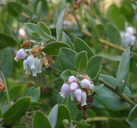Taxon Report
Arctostaphylos cruzensis RoofArroyo de la Cruz manzanita |
 © 2006 Steve Matson |
Taxon Summary
Arctostaphylos cruzensis, commonly known as Arroyo de la Cruz manzanita, is a perennial evergreen shrub in the Ericaceae that is found only in California. It occurs within Broadleafed upland forest, Chaparral, Closed-cone coniferous forest, Coastal bluff scrub, Coastal scrub, and Valley and foothill grassland, growing at elevations from 60 to 310 meters. Arctostaphylos cruzensis is ranked 1B.2, Plants Rare, Threatened or Endangered in California and Elsewhere; Moderately threatened in California.Classification
|
Scientific Name: |
Arctostaphylos cruzensis Roof |
|
Common Name: |
Arroyo de la Cruz manzanita |
| Family: | Ericaceae |
| Element Code: | PDERI040B0 |
| USDA Plants Symbol: | ARCR6 |
|
Synonyms/Other Names: |
|
Ecology and Life History
| Lifeform: | perennial evergreen shrub |
| Blooming Period: Dec-Mar | Dec-Mar |
| Elevation: | 60-310 (195-1015) |
| General Habitats: | Broadleafed upland forest, Chaparral, Closed-cone coniferous forest, Coastal bluff scrub, Coastal scrub, Valley and foothill grassland |
| Microhabitat: | Sandy |
| Microhabitat Details: |
Conservation Status
| CA Rare Plant Rank: | 1B.2 |
| Global Rank: | G1G2 |
|
State Rank: |
S1S2 |
| State List: | None |
| Fed List: | None |
| Other Status: | BLM_S; SB_SBBG; USFS_S |
|
CRPR Changes: |
|
Occurrence Data from the CNDDB
| Total Occurrences: | 8 |
| Element Occurrence Ranks: | |
| Excellent (A) | 2 |
| Good (B) | 0 |
| Fair (C) | 2 |
| Poor (D) | 0 |
| None (X) | 0 |
| Unknown (U) | 4 |
| California Endemic: True | |
| California Counties and Islands: Name (Code) | |
| Monterey (MNT), San Luis Obispo (SLO) | |
| Quads: Name (Quad Code) | |
| Cambria (3512151), Cape San Martin (3512184), Piedras Blancas (3512163) | |
Threat List Data from the CNDDB
| Threat List Total: | 4 | |
| EOs with Threat Listed: | Total EOs | % of EOs |
| 3 | 38 % | |
| Grazing | 2 | 25% |
| Other | 1 | 12% |
| Wood cutting or brush clearing | 1 | 12% |
| Foot traffic/trampling | 1 | 12% |
Citation
California Native Plant Society, Rare Plant Program. 2025. Rare Plant Inventory (online edition, v9.5.1). Website https://www.rareplants.cnps.org [accessed 23 December 2025].